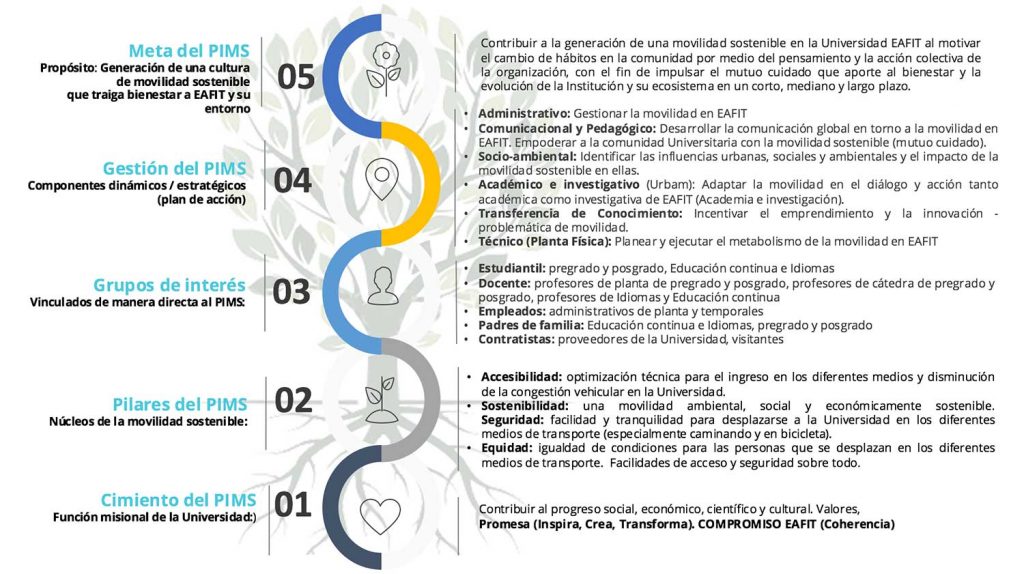Sustainable Mobility Institutional Plan EAFIT University: A Systemic Journey Towards a Cultural Evolution

1. EAFIT as Organizational Being
The EAFIT University is one of the top institutions of higher education in Colombia as well as recognized for its International outlook. Moreover, it is well-known as one of the leading universities in encouraging interdependencies between the academy, the public and the private sectors both locally and nationally.
Over the last years EAFIT has furthered its sustainable approach. A commitment decidedly conveyed through the purpose of interweaving its organizational dynamic (strategy) with “the Sustainable Development Goals (SDGs); the UN Framework Convention on Climate Change (COP21); the UN Global compact, in which EAFIT joined in 2011; The World’s Green Universities Measure (Green Metrics) in which the University takes part since 2014; and the institutional policy entrenched in the Principles of Governance and Management related to Biodiversity and Environment Conservation.” (Universidad EAFIT, 2018)

2. The Issue: A Culture of Unsustainable Mobility
A common metabolic disorder of ecobiopsychosocial living systems, such as cities, has to do with an unhealthy mobility and hence with pollution (both match with arterial disease and smoking in the case of humans). In short, that issue informs the prevalent socio-economic model which conceives the city as a machine (Cartesian view), i.e., as a means of production and consumption that almost does not bear in mind the several species and ecosystems that dwell upon it.
EAFIT –likewise every company comprising the Aburrá Valley– is in the midst of this overarching situation both as originator of and affected by the unsustainable mobility. Despite the University has heretofore grappled with this city concern across certain of its missional focus (research, innovation, entrepreneurship, inter alia), it was until 2014 that resolved to concretely address this problem in its institutional wholeness. Here Jscinteractivo had the first approach with the Communication Office in order to estimate specific needs and then to suggest a working plan.
3. The Process: Systems or Ecological Thinking
Further than Communication, Collective Action
At first, the priority of this organ in charge of making the University visible was to assemble a communication plan supported by a campaign aimed to promoting the use of alternative ways of transportation to travel to the campus in addition to the particular automobile. Nonetheless, after listening to the initial conversations, Jscinteractivo suggested going beyond communicational aspects and rather freeing a systemic organizational development process towards pursuing a sustainable mobility on the EAFIT’s community.
The Insightful Conversation
Thereby, the EAFIT’s mobility planning started being embraced by Jscinteractivo’s methodology: The Insightful Conversation©. By dint of this ecological feedback loop we began to identify and foresee a sequence of systemic solutions to deal with the hardships from an unhealthy mobility.
The first step implied harnessing an interdisciplinary crew of working constituted by leaders from different areas with direct agency on the organization’s mobility. In this direction, it was intended to bind the EAFIT’s collective intelligence to attempt accurate actions over such issue. Consequently, by starting a collective dialog, it was settled an analysis application for overlapping the assumptions that came up from the group with the entire University’s community. Further than a survey it mostly entailed both deep listening, observation and conversation.
The diagnosis outcomes on the Institution mobility’s ‘perception and reality’ allowed to conclude what formerly it had been inferred: the unsustainable mobility is a cultural problem. Hence the main Jscinteractivo’s recommendation was envisioning an integral sustainable mobility planning which pointed out towards a necessary cultural evolution not only for the sake of EAFIT but the Metropolitan territory.
4. The Solution: ‘acting to encourage’ Sustainable Mobility Institutional Plan (SMIP) EAFIT University
The EAFIT’s Sustainable Mobility Institutional Plan (SMIP) is not a ‘Transportation plan’. It is a change management effort that emerges through a collective conversation from the University. The SMIP’s essential purpose is to contribute to the generation of a sustainable mobility culture that brings wellbeing for EAFIT as well as its surroundings. In being a cultural transformation it is sustained by an educational approach aiming for the long run. In fact, such projection is linked to the EAFIT’s commitment with the SDGs achievement established on the 2030 UN Global Compact Agenda.
The Tree of Sustainable Mobility for EAFIT

A simple way of explaining the EAFIT’s SMIP is by means of a tree analogy. Regarding its simplicity, it is a powerful icon to explain the emerging complexity from a systemic process of learning and transformation. So the tree of life from a culture of sustainable mobility is revealed as follows:
- Roots (SMIP’s basis): In the roots is found the University’s missional function (‘To contribute to the social, economic, scientific and cultural progress of the country…’) in coherence with the SMIP’s purpose. This is where the EAFIT’s commitment is validated in regard to both the SDGs and its promise of sustainably inspiring, creating and transforming society.
- Stem (SMIP’s pillars): In the stem are located the basic pillars of a sustainable mobility in EAFIT (Universal Access, Health, Safety, Inclusion, and Competitiveness). That is, a mobility which ensures a progressive cycle (today, in the future) of wellbeing to the regional ecosystem.
- Treetop beginning (SMIP’s Stakeholders): In the treetop foundation are gazed the EAFIT’s stakeholders, the SMIP’s reason of being. In such intersection the pillars are merged with the interdependent branches which should conduct to EAFIT towards an active mobility.
- Branches and leaves (SMIP’s management): The branches and the leaves convey the systemic conversation between those different organizational strategic (dynamic) components that must lead, foster, map, and confirm the results from the SMIP’s development (the parts of the whole, i.e., the SMIP itself).
- Flowers and fruits (SMIP’s goal): Lastly the tree is going to blossoming and bearing the expected fruits to the extent the SMIP’s purpose is being reached (commitment, knowledge and patient):
To locally, regionally and nationally contribute to the generation of a sustainable mobility culture in encouraging a shift in the EAFIT’s community habits through systems thinking and action sustained by the three essential reasons of EAFIT University: learn, discover and create, as well as social forecasting, in order to propel mutual aid for the sake of the Institution and its habitat in the short, medium and long term.(Translated from Universidad EAFIT, 2018)
5. The Achievement: A Good Sowing in EAFIT

Due to a changing management style rooted in ‘pedagogy’ further than ‘technic’ which is seeking the shift from an unhealthy mobility to a generative one, Jscinteractivo has fostered a good sowing in EAFIT. The Sustainable Mobility Institutional Plan (SMIP), whose motto is ‘acting to encourage’, is precisely conceived as the seed the Institution must care as a means to reap the benefits of its development.
The most significant achievement cultivated by the Jscinteractivo’s Organizational Development Systemic Consultancy can be briefly expressed on these three aspects as follows:
- Facilitating organizational systems thinking and action to cooperatively face the mobility problem at the University. Siloed thinking is another quite common issue suffered by companies. It hampers collaborative work and therefore the healthy development of any organization.
- Motivating organizational proactivity in anticipating solutions for the unsustainable mobility. The SMIP started taking form by the end of 2014, even before the first Resolution (2381) of 2015 issued by The Metropolitan Area of the Aburrá Valley (MAAV) came into effect (a verdict to demand Business Plans of Sustainable Mobility –BPSM according to MAAV– on public and private organizations with more than 200 employees).
- Devising a plan, within a collective conversation, that ‘transcends specific mobility procedures’ and rather becomes in a fundamental pursuing of cultural evolution not only to EAFIT but the city (Medellín) and the length and breadth of the region (Aburrá Valley). Likewise, with the SMIP it was reinforced the institutional commitment with the SDGs’ achievement (the goals 3 and 11 are now incorporated).

6. Present and Forecast: The need of interdependencies
The Sustainable Mobility, a Shared Purpose in the Aburrá Valley
In coping with an unhealthy mobility soared by a cultural behavior derived from the prevalent socio-economic model, it is a paramount to stimulate mutual aid between the organizations that shape a territory. Nevertheless, it is also important to notice how such mindset simultaneously constrains our reciprocal nature. Hence the MAAV as environmental authority has been on top of driving and regulating the way we are moving down the city-region by use of the current Resolution 1379 of 2017 which replaced the former of 2015.
Thus, supported by Jscinteractivo the University recently allied its sustainable mobility project –defined earlier between 2014 and 2015– with the BPSM guidelines formulated by the Metropolitan Area. The SMIP is now the result of integrating the University’s outlook with the rules promulgated by this public entity. That’s how the goal of cultural transformation assumed by EAFIT is currently bound to the shared purpose encouraged by the MAAV with the intention of collaboratively reaching a conscious and healthy mobility between the overall crew of business organizations that inhabit the Aburrá Valley.

Conceived by Jscinteractivo and designed by the Communication Office / Creative Communication Area EAFIT University
The Sustainable Projection of Mobility in EAFIT
As has been demonstrated, the SMIP already had a well-defined systemic structure before being fused to the MAAV’s guidelines. However, such integration has allowed to reciprocally tailor responsibilities as well as optimizing actions to coherently foresee a generative mobility at EAFIT.
In addition to consolidate the EAFIT’s commitment towards a sustainable mobility –and so to the SDGs– the SMIP is a relevant milestone in affirming the environmental standards assumed by the institution in order to diminish, control and compensate air polluting emissions implied in its endeavors (Universidad EAFIT, 2018). Besides, this interaction has facilitated a clear derivation of duties on different levels of the organization (from senior management and so forth). An accurate manner of scoping out the advances both in the short (2020), medium (2025), and long (2030) run.
7. Conclusion: ‘For Systemic Problems, Systemic Solutions’
Therefore, it can be argued that enhancing the way the University is moving is contributing to its evolution as a reflexive, conversational and interdependent living system. Furthermore, is being tracing The Ecobiopsychosocial Capital not only of this organization but the entire regional ecosystem.
The EAFIT University as agent of change has acknowledged its responsibility over this collective effort. Also knows that facing interdependent problems, such as the unhealthy mobility on the region, must be similarly tackled with systemic solutions.
A journey of evolution which started by conversing.
Jscinteractivo
Changing Starts by Conversing
Author: Juan Sebastián Cárdenas Salas (September, 2018)
For Spanish version click here
Bibliographical references
Universidad EAFIT (2018). Plan Institucional de Movilidad Sostenible (PIMS) EAFIT.

